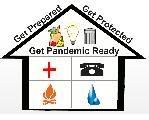# 2967
While it is true that earthquakes, unlike tornadoes and hurricanes, know no season – we do observe April as National Earthquake Preparedness month.
USGS map
As you can see by the map above, most of the United States is seismically active – with Alaska, Hawaii, the west coast, and the mid-west seeing the most – and strongest, quakes.
Few places, however, can claim to be completely immune to quakes.
Even in Florida, which is about as seismically quiet as it comes – we’ve recorded quakes. And of course, quakes in the Gulf of Mexico, Atlantic, or Caribbean are even capable of sending Tsunami’s our way.
Over the past week, more than 1,000 quakes (most of them very minor) have been recorded in the United States. They are an ever present reminder that we live on changing planet.

While we can’t know when the next big earthquake will hit, or on what fault line it will strike, we do know that the earth is constantly shifting beneath our feet.
Tectonic pressures build, and spread, and at some point a quake occurs.
People who live in quake areas need not only to be prepared for a disaster, they need to take specific earthquake precautions as well.
And while we think of California, and the Pacific Northwest as being at greatest risk for a major quake, states like Kentucky, Illinois, Missouri, Arkansas and Tennessee are in high risk areas as well. So too is South Carolina.
Even New York City has fault lines running beneath it.
While the last significant quake occurred there in 1884, with a magnitude 5.2 off shore from Far Rockaway Beach, scientists believe a quake of that size is likely to occur every 100 years or so.
Areas that seldom see quakes, like New York City, generally don’t build structures with earthquakes in mind – meaning that a smaller magnitude quake there could be more damaging than a larger quake in Los Angeles.
The American Red Cross reminds everyone that April is National Earthquake Preparedness Month, and urges you to become better aware of the dangers, and better prepared to deal with them.
This advice from the Orange Country Chapter of the American Red Cross.
April is Earthquake Preparedness Month
Make a Plan
Planning ahead is the first step to a calmer and more assured disaster response.
Talk with your family about potential disasters.
Plan to share responsibilities and work together as a team.
Plan and designate a place to meet after a disaster has struck.
Designate an out-of-state friend to be your family contact.
Learn how and when to turn utilities off (water, gas and electricity).
Tell everyone in the home where emergency contact information is located.
Install smoke detectors on each level of your home, especially near bedrooms. Remember to test smoke detectors monthly and change batteries at least once a year.
Determine the best escape routes out of your home.
Check if you have adequate insurance coverage.
Take a Red Cross first aid and CPR Class.
Practice the plan.
Build a Kit
Keep your disaster supply items in a sturdy, easy-to-carry container such as a backpack, duffle bag or covered container and store in a convenient location known to the entire family. Remember to check dates of both food items and batteries and change water supply every six months for freshness. Keep enough supplies in your disaster supply kit to meet the needs of your family for a minimum of three days. Remember to prepare for family members with special requirements, such as infants, elderly or disabled persons.
Water (a minimum of one gallon per person per day).
Food (non-perishable, high-protein items).
First aid kit (including prescription and non-prescription medicine).
Flashlight (including extra batteries).
Tools and supplies (including scissors, aspirin, knife, can opener and sanitary supplies).
Battery-operated radio.
Clothing and bedding (one set of clothing and shoes per family member and sleeping articles).
Money.
Pet supplies (including food, water, leash and medication).
Map of the surrounding area.
Contact information.
For more information on how to prepare for earthquakes and emergencies of all types, please visit the following sites.
FEMA http://www.fema.gov/index.shtm
READY.GOV http://www.ready.gov/
AMERICAN RED CROSS http://www.redcross.org/
For Pandemic Preparedness Information: HHS Individual Planning Page
For more in-depth emergency preparedness information I can think of no better resource than GetPandemicReady.Org.
Related Post:
Widget by [ Iptek-4u ]

